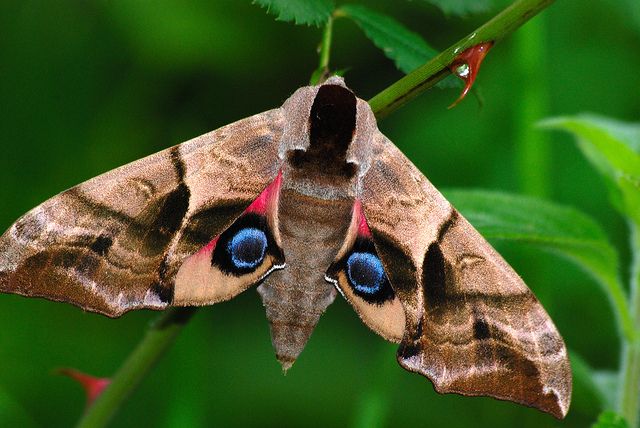Major’s Moths

One of our guests staying at Majors Lodge took advantage of a fine evening on June 22nd and set up a moth trap to see what nocturnal creatures might appear and we were stunned to find that they recorded 55 different species before releasing them back into the wild!
There were many common species and also several which are rare but it was the sheer variety which gave us confidence that the land management techniques we are utilising here at Watatunga is paying dividends for the local wildlife. Moths are a vitally important link in the food chain, both as adult and larvae, and are also essential pollinators for a variety of plants and trees. Many birds and bats rely on these creatures for food throughout the year and especially around breeding time when many are on the wing and their caterpillars are gathering in number on their favoured food plant. Here are some facts about a few of the moths found in the trap.


This is a Brimstone moth – An unmistakable yellow moth with chestnut-brown markings on the tips and along the leading edge of the forewings. They also have a white crescent or dash near to the leading forewing edge.
They can frequently be seen on the wing just before dusk and they are regularly attracted to light. Some overwinter as part-grown larvae on the foodplant but others as pupae in cocoons on the plant, in debris below it or in a crack in a wall. Brimstone caterpillars feed on range of trees and bushes including Blackthorn, Hawthorn, and Rowan; all of which are found at Watatunga.
The Eyed Hawk-moth is glorious! Only found as an adult between June and July, this large moth (70-80mm) will have over-wintered as a large dark pupa below the larval foodplant before hatching and taking flight. The adult moths cannot feed so their sole purpose is to mate and continue their lineage.
The moth will eventually burn up the energy reserves it made as a greedy caterpillar and die of a combination of starvation and exhaustion. Caterpillars feed on Sallow, Apple, wild and ornamental Crab Apple and occasionally Poplar.


The White Ermine is a variable moth with small black spots on the forewing, however, the number of black spots varies greatly from largely white examples which are almost entirely plain to those with many more spots that may even join together to form streaks along the wing veins. The white wing colour can also vary with creamy-buff or even brown examples often found in Scotland.
The hairy larvae can be seen from July to September which then overwinter as pupae among plant debris. A member of the tiger Moth family, caterpillars feed on a wide range of herbaceous plants including Common Nettle and docks.
Having such a wide variety of species shows that the habitat here provides a wealth of different options for so many moths and for the past few years we have been using a fantastic piece of technology called a hydro-seeder to help create these habitats.
The hydro-seeder sprays a vivid green mixture of water and wildflower and grass seeds directly onto the ground where a wood mulch incorporated into the mix helps to support germination. The solidified mixture also holds onto the soil surface, helping to stabilising it and limit erosion, which is important on steep banks. Hydro-seeding is an efficient way to plant nature-friendly plants and it’s also quite fun to use!! We aim to increase the variety of plants in the mixes which will help to broaden the species the reserve attracts.


Whilst often overlooked in favour of their day-flying cousins, the butterflies, moths are equally important in a healthy ecosystem and vital for biodiversity. If you are planning a stay at Major’s Lodge or Stable Cottage, why not bring a moth trap yourself so that you can explore the magical world that is often hidden as we sleep?
Below is the full list of species caught last week at Major’s Lodge:
Barred Yellow Cidaria fulvata
Beautiful Hook-tip Laspeyria flexula
Blotched Emerald Comibaena bajularia
Bright-line Brown-eye Lacanobia oleracea
Brimstone Opisthograptis luteolata
Brown Rustic Rusina ferruginea
Buff Arches Habrosyne pyritoides
Buff Ermine Spilosoma lutea
Buff-tip Phalera bucephala
Burnished Brass Diachrysia chrysitis
Cinnabar Tyria jacobaeae
Clouded Border Lomaspilis marginata
Clouded Silver Lomographa temerata
Common Carpet Epirrhoe alternata
Common Footman Eilema lurideola
Common Pug Eupithecia vulgata
Common Wainscot Mythimna pallens
Coronet Craniophora ligustri
Elephant hawk Deilephila elpenor
Eyed Hawk Smerinthus ocellata
Fan-foot Herminis tarsipennalis
Flame Axylia putris
Flame Shoulder Ochropleura plecta
Four-dotted Footman Cybosia mesomella
Foxglove Pug Eupithecia pulchellata
Garden Carpet Xanthorhoe fluctuata
Heart & Dart Agrotis exclamationis
Ingrailed Clay Diarsia mendica
Knot grass Acronicta rumicis
Large Twin-spot Carpet Xanthorhoe quadrifasiata
Large Yellow underwing Noctua pronuba
Lobster Stauropus fagi
Lychnis Hadena bicruris
Marbled Minor Oligia strigilis
Mottled Rustic Caradrina morpheus
Pale Prominent Pterostoma palpina
Pale Tussock Calliteara pudibunda
Peppered Moth Biston betularia
Pine hawk Sphinx pinastri
Riband Wave Idaea aversata
Rosy footman Miltochrista miniata
Sandy Carpet Perizoma flavofasciata
Scarce footman Eilema complana
Scorched Wing Plagodis dolabraria
Setaceous Hebrew Character Xestia c-nigrum
Shoulder-striped Wainscot Leucania comma
Snout Hypena proboscidalis
Spectacle Abrostola tripartita
Straw Dot Rivula sericealis
Swallowtailed moth Ourapteryx sambucaria
Sycamore Acronicta aceris
Tawny Shears Hadena perplexa
Vines Rustic Hoplodrina ambigua
White Ermine Spilosoma lubricipeda
Willow Beauty Peribatodes rhomboidaria